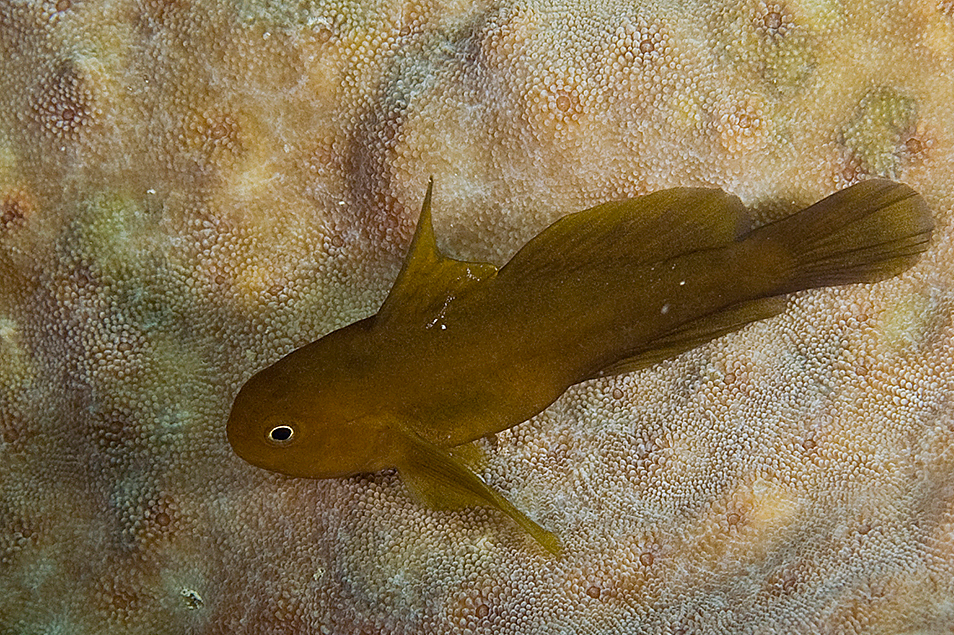- Classification
- ACTINOPTERYGII
- PERCIFORMES
- GOBIIDAE
- Gobiodon
- acicularis
Needlespine Coralgoby, Gobiodon acicularis Harold & Winterbottom 1995
Other Names: Needlespine Coral Goby

A Needlespine Coralgoby, Gobiodon acicularis, in Palau, September 2015. Source: terence zahner / iNaturalist.org. License: CC By Attribution-NonCommercial
Summary:
A yellowish-brown to black coralgoby with an elongate, filamentous first dorsal-fin spine and a triangular first dorsal fin with the spines decreasing progressively in height posteriorly.
Coralgobies are highly specialised and live exclusively between branches of living acroporid corals.
Coralgobies are highly specialised and live exclusively between branches of living acroporid corals.
Cite this page as:
Bray, D.J. 2021, Gobiodon acicularis in Fishes of Australia, accessed 27 Jun 2025, https://fishesofaustralia.net.au/Home/species/2233
Needlespine Coralgoby, Gobiodon acicularis Harold & Winterbottom 1995
More Info
|
Distribution |
Northern Great Barrier Reef, Queensland. Elsewhere the species occurs in the Western Pacific: Papua New Guinea, the Solomon Islands, Palau and northeastern Australia. These obligate coral-dwelling gobies live exclusively between branches of acroporid corals, especially those of the genera Echinopora and Hydnophora. A coralgoby pair inhabits the same coral colony for most of their adult life. |
|
Features |
Dorsal fin VI + I, 10-11; Anal fin I, 9. Body depth at level of pelvic fin 2.0-2.5 in SL; first dorsal-fin spine elongate and filamentous; triangular first dorsal fin; pelvic fin reaching anus, pelvic-fin frenum and basal membrane complete; scales absent. |
|
Feeding |
Feeds on coral tissue, mucous, filamentous algae, detritus and tiny invertebrates from the . |
|
Biology |
Coralgobies are hermaphrodites, and individuals can change sex bi-directionally - from female to male and male to female. This ensures that there is always a breeding pair within a coral head. |
|
Conservation |
Coralgobies are vulnerable to the affects of climate change, as they are obligate coral dwellers, only occuring on acroporid corals of the genera Echinopora and Hydnophora. |
|
Etymology |
The species is named acicularis in reference to the elongate spine of the first dorsal fin. |
|
Species Citation |
Gobiodon acicularis Harold & Winterbottom 1995, Proceedings of the Biological Society of Washington 108(4): 688, figs 1-2. Type locality: off Babelthuap Island, coral-enclosed area north of Arakataoch Stream, Belau (Palau), western Pacific. |
|
Author |
Bray, D.J. 2021 |
|
Resources |
Needlespine Coralgoby, Gobiodon acicularis Harold & Winterbottom 1995
References
Allen, G.R. & Erdmann, M.V. 2012. Reef fishes of the East Indies. Perth : Tropical Reef Research 3 vols, 1260 pp.
Brooker, R.M., Munday, P.L. & Ainsworth, T.D. 2010. Diets of coral-dwelling fishes of the genus Gobiodon with evidence of corallivory. Journal of Fish Biology 76: 2578–2583, https://doi.org/10.1111/j.1095-8649.2010.02644.x
Comte, L. & Olden, J.D. 2017. Climatic vulnerability of the world’s freshwater and marine fishes. Nature Climate Change 7: 718-722.
Duchene D., Klanten, S.O., Munday, P.L., Herler, J. & van Herwerden, L. 2013. Phylogenetic evidence for recent diversification of obligate coral-dwelling gobies compared with their host corals. Molecular Phylogenetics and Evolution 69: 123-132
Harold, A.S. & Winterbottom, R. 1995. Gobiodon acicularis, a new species of gobioid fish (Teleostei: Gobiidae) from Belau, Micronesia. Proceedings of the Biological Society of Washington 108(4): 687-694 See ref at BHL
Harold, A.S., Winterbottom, R., Munday, P.L & Chapman, R.W. 2008. Phylogenetic relationships of Indo-Pacific coral gobies of the genus Gobiodon (Teleostei: Gobiidae), based on morphological and molecular data. Bulletin of Marine Science 82: 119-136.
Larson, H. 2020. Gobiodon acicularis. The IUCN Red List of Threatened Species 2020: e.T193147A2200875. https://dx.doi.org/10.2305/IUCN.UK.2020-2.RLTS.T193147A2200875.en. Downloaded on 19 January 2021.
Larson, H.K. & Murdy, E.O. 2001. Eleotridae, Gobiidae. pp. 3574-3604 in Carpenter, K.E. & Niem, T.H. (eds). The Living Marine Resources of the Western Central Pacific. FAO Species Identification Guide for Fisheries Purposes. Rome : FAO Vol. 6 pp. 3381-4218.
Munday, P.L., Harold, A.S. & Winterbottom, R. 1999. Guide to coral-dwelling gobies, genus Gobiodon (Gobiidae), from Papua New Guinea and the Great Barrier Reef. Revue Française d’Aquariologie Herpétologie 26(1-2): 53-58, http://pascal-francis.inist.fr/vibad/index.php?action=getRecordDetail&idt=1193131
Myers, R.F. 1999. Micronesian Reef Fishes. A comprehensive guide to the coral reef fishes of Micronesia. Guam : Coral Graphics vi 330 pp. 192 pls.
Nilsson, G.E., Hobbs, J.-P.A. & Ostlund-Nilsson, S. 2007. Tribute to P. L. Lutz: respiratory ecophysiology of coral-reef teleosts. Journal of Experimental Biology 210: 1673-1686.
Nilsson, G.E., Hobbs, J.-P.A., Ostlund-Nilsson, S. & Munday, P.L. 2007. Hypoxia tolerance and air-breathing ability correlate with habitat preference in coral-dwelling fishes. Coral Reefs 26: 241-248.
Schubert, M. 1999. Skin toxins and the ecology of coral gobies (Gobiodon: Gobiidae), Honours thesis, James Cook University, Townsville.




